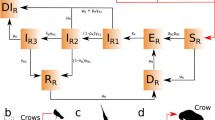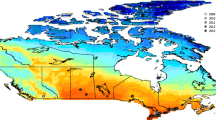Abstract
We examined the ecological factors influencing population declines in American crows (Corvus brachyrhynchos) as they were initially exposed to West Nile virus (WNV), a pathogen first detected in the US in 1999 that has since become one of North America’s most prevalent vector-borne pathogens. The strongest effects were initial crow population density (denser populations were more likely to suffer declines), avian species diversity (populations in areas with high diversity were less likely to suffer a decline), human population density (populations were more likely to decline in more urban areas), and time since the pathogen’s introduction to the US (populations exposed to the pathogen later in its North American sweep were less likely to suffer declines than those exposed earlier). Variables that played only a minor role included rainfall, mean maximum temperature, and total number of birds, used as a proxy for the overall reservoir competence of the community. These findings indicate that WNV declined in virulence during its rapid 5-year sweep and support the importance of the ‘dilution effect’ whereby a diverse host community dampens pathogen transmission and potentially slows its rate of spread. Results underscore the need for considering the entire community when trying to understand the factors shaping disease risk.



Similar content being viewed by others
References
Allan BF, Keesing F, Ostfeld RS (2003) Effect of forest fragmentation on Lyme disease risk. Conserv Biol 17:267–272
Allan BF et al (2009) Ecological correlates of risk and incidence of West Nile virus in the United States. Oecologia 158:699–708
Anderson DR (2008) Model based inference in the life sciences: a primer on evidence. Springer, New York
Augustin NH, Mugglestone MA, Buckland ST (1996) An autologistic model for the spatial distribution of wildlife. J Appl Ecol 33:339–347
Banet-Noach C, Simanov L, Malkinson M (2003) Direct (non-vector) transmission of West Nile virus in geese. Avian Pathol 32:489–494
Begon M (2008) Effects of host diversity on disease dynamics. In: Ostfeld RS, Keesing F, Eviner VT (eds) Infectious disease ecology: effects of ecosystems on disease and of disease on ecosystems. Princeton University Press, Princeton, pp 12–29
Betts MG et al (2009) Comment on “Methods to account for spatial autocorrelation in the analysis of species distributional data: a review”. Ecography 32:374–378
Bradley CA, Gibbs SEJ, Altizer S (2008) Urban land use predicts West Nile virus exposure in songbirds. Ecol Appl 18:1083–1092
Bull JJ (1994) Perspective: virulence. Evolution 48:1423–1437
Burnham KP, Anderson DR (2002) Model selection and multimodel inference: a practical information-theoretic approach, 2nd edn. Springer, New York
Bystrack D (1981) The North American breeding bird survey. Stud Avian Biol 6:34–41
Caffrey C, Smith SCR, Weston TJ (2005) West Nile virus devastates an American crow population. Condor 107:128–132
CDC: Center for Disease Control and Prevention (2008) West Nile virus: statistics, surveillance, and control. http://www.cdc.gov/ncidod/dvbid/westnile/surv&control.htm
Clark AB, Robinson DA Jr, McGowan KJ (2006) Effects of West Nile virus mortality on social structure of an American crow (Corvus brachyrhynchos) population in upstate New York. Ornithol Monogr 60:65–78
Dobson A (2004) Population dynamics of pathogens with multiple host species. Am Nat 164:S64–S78
Ezenwa VO, Godsey MS, King RJ, Guptill SC (2006) Avian diversity and West Nile virus: testing associations between biodiversity and infectious disease risk. Proc R Soc Lond B 273:109–117
Fenner R, Ratcliffe FN (1965) Myxomatosis. Cambridge University Press, Cambridge
Galvani AP (2003) Epidemiology meets evolutionary ecology. Trends Ecol Evol 18:132–139
Ganusov VV, Bergstrom CT, Antia R (2002) Within host population dynamics and the evolution of microparasites in a heterogeneous host population. Evolution 56:213–223
Hartemink NA, Davis SA, Reiter P, Hubálek Z, Heesterbeek JAP (2007) Importance of bird-to-bird transmission for the establishment of West Nile virus. Vector Borne Zoonotic Dis 7:575–584
Hochachka WM, Dhondt AA, McGowan KJ, Kramer LD (2004) Impact of West Nile virus on American crows in the northeastern United States, and its relevance to existing monitoring programs. EcoHealth 1:60–68
Keesing F, Holt RD, Ostfeld RS (2006) Effects of species diversity on disease risk. Ecol Lett 9:485–498
Kilpatrick AM, Daszak P, Jones MJ, Marra PP, Kramer LD (2006) Host heterogeneity dominates West Nile virus transmission. Proc R Soc Lond B 273:2327–2333
Kilpatrick AM, LaDeau SL, Marra PP (2007) Ecology of West Nile virus transmission and its impact on birds in the Western Hemisphere. Auk 124:1121–1136
Koenig WD, Marcus L, Scott TW, Dickinson JL (2007) West Nile virus and California breeding bird declines. EcoHealth 4:18–24
Komar N (2003) West Nile virus: epidemiology and ecology in North America. Adv Virus Res 61:185–234
Komar N, Langevin S, Hinten S, Nemeth N, Edwards E, Hettler D (2003) Experimental infection of North American birds with the New York 1999 strain of West Nile virus. Emerg Infect Dis 9:311–322
Komar N et al (2005) Avian hosts for West Nile virus in St. Tammany Parish, Louisiana, 2002. Am J Trop Med Hyg 73:1031–1037
LaDeau SL, Kilpatrick AM, Marra PP (2007) West Nile virus emergence and large-scale declines of North American bird populations. Nature 447:710–714
Landesman WJ, Allan BF, Langerhans RB, Knight TM, Chase JM (2007) Inter-annual associations between precipitation and human incidence of West Nile virus in the United States. Vector Borne Zoonotic Dis 7:337–343
Lloyd-Smith JO, George D, Pepin KM, Pitzer VE, Pulliam JRC, Dobson AP, Hudson PJ, Grenfell BT (2009) Epidemic dynamics at the human–animal interface. Science 326:1362–1367
LoGiudice K, Ostfeld RS, Schmidt KA, Keesing F (2003) The ecology of infectious disease: effects of host diversity and community composition on Lyme disease risk. Proc Natl Acad Sci USA 100:567–571
Loss SR et al (2009) Avian host community structure and prevalence of West Nile virus in Chicago, Illinois. Oecologia 159:415–424
Ostfeld RS, Keesing F (2000a) Biodiversity and disease risk: the case of Lyme disease. Conserv Biol 14:722–728
Ostfeld RS, Keesing F (2000b) Biodiversity series: the function of biodiversity in the ecology of vector-borne zoonotic diseases. Can J Zool 78:2061–2078
PRISM (2008) PRISM Group, Oregon State University. http://www.prismclimate.org
R Development Core Team (2009) R: a language and environment for statistical computing. R Foundation for Statistical Computing, Vienna, Austria. http://www.R-project.org. ISBN3-900051-07-0
Schmidt KA, Ostfeld RS (2001) Biodiversity and the dilution effect in disease ecology. Ecology 82:609–619
Smallwood KS, Nakamoto B (2009) Impacts of the West Nile virus epizootic on the yellow-billed magpie, American crow, and other birds in the Sacramento Valley, California. Condor 111:247–254
Snapinn KW, Holmes EC, Young DS, Bernard KA, Kramer LD, Ebel GD (2007) Declining growth rate of West Nile virus in North America. J Virol 81:2531–2534
Soverow JE, Wellenius GA, Fisman DN, Mittleman MA (2009) Infectious disease in a warming world: how weather influenced West Nile virus in the United States (2001–2005). Environ Health Perspect 117:1049–1052
Swaddle JP, Calos SE (2008) Increased avian diversity is associated with lower incidence of human West Nile infection: observation of the dilution effect. PLoS One 3:e2488
Verbeek NA, Caffrey C (2002) American crow (Corvus brachyrynchos). In: Poole A (ed) Birds of North America online. Cornell Lab of Ornithology, Ithaca. http://bna.birds.cornell.edu/bna/species/647
Wheeler SS et al (2009) Differential impact of West Nile virus on California birds. Condor 111:1–20
Wintle BA, Bardos DC (2006) Modeling species-habitat relationships with spatially autocorrelated observation data. Ecol Appl 16:1945–1958
Yaremych SA, Warner RE, Mankin PC, Brawn JD, Raim A, Novak R (2004) West Nile virus and high death rate in American crows. Emerg Infect Dis 10:709–711
Acknowledgments
Indirect support for this work was provided by the National Science Foundation. We thank André Dhondt and an anonymous reviewer for their comments, the members of the Bird Populations Studies group for suggestions, and the many volunteers who have gathered Breeding Bird Survey data over the years.
Author information
Authors and Affiliations
Corresponding author
Additional information
Communicated by Herwig Leirs.
Rights and permissions
About this article
Cite this article
Koenig, W.D., Hochachka, W.M., Zuckerberg, B. et al. Ecological determinants of American crow mortality due to West Nile virus during its North American sweep. Oecologia 163, 903–909 (2010). https://doi.org/10.1007/s00442-010-1627-z
Received:
Accepted:
Published:
Issue Date:
DOI: https://doi.org/10.1007/s00442-010-1627-z




